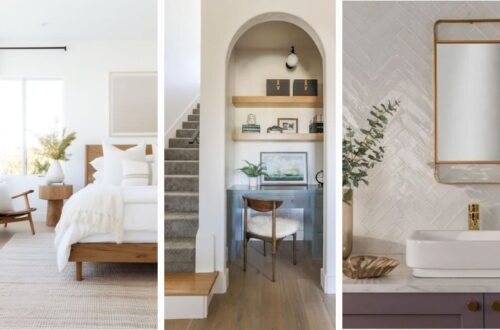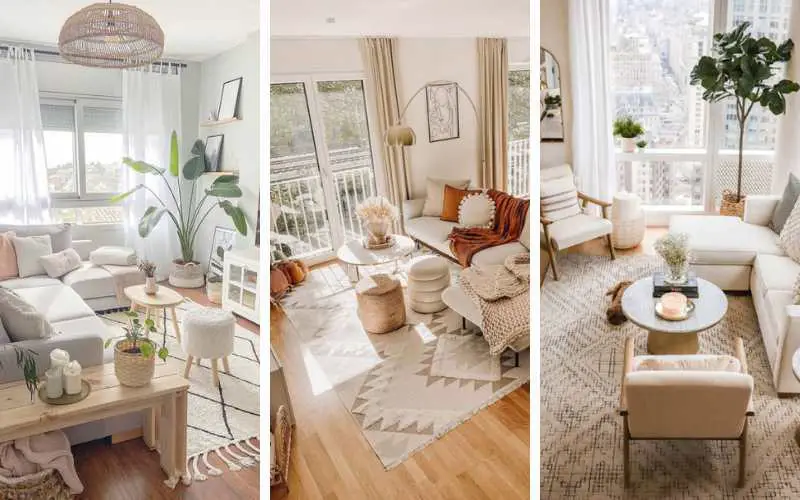
Small Living Room Ideas | 20 Decor Tips
Share this
Small living room ideas that transform your space into a stylish and functional haven. Explore tips and tricks to maximize every inch, making your living room look and feel larger.
If you possess a cozy living room and dream of transforming it, this article unfolds 20 effortlessly implementable ideas to infuse your small space with style, functionality, and elegance.
This article is made for anyone with a compact living room looking to renovate or rejuvenate its look. We will explore numerous intriguing and straightforward ideas to apply.
Small living room ideas Light colors
In optimizing small living areas, light colors emerge as the go-to choice for creating an illusion of a more spacious and airy room.
Whites and soft, neutral tones stand out as the optimal selections for maximizing the perceived size of a compact space.
The strategy of establishing monochromatic environments devoid of sharp color transitions plays a pivotal role in fostering a sense of unity within the room.
For those with a penchant for vibrant hues, incorporating these colors through smaller accessories such as cushions, throws, vases, or flowers can infuse your space with lively color while maintaining a perception of expansiveness and comfort.
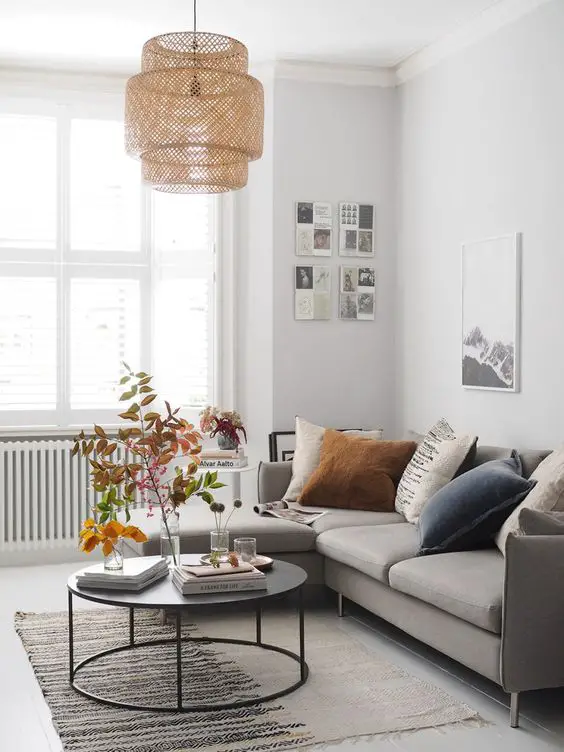
In the case of this exemplary small living space, the dominant colors are light neutral shades like white and gray, applied to large areas and elements including walls, rugs, and furniture.
Accent colors are introduced through smaller-scale items.
The accent hues selected are soft and bright, seamlessly blending into the space without causing a stark contrast.
This approach demonstrates a sophisticated method to elevate the aesthetic of small living quarters, making it both visually appealing and functionally spacious.
Don’t forget to Pin!


Sofa
When considering the design of a small living room, one critical aspect to keep in mind is the choice of furniture, particularly when it comes to selecting a sofa.
The rule of thumb is to choose a sofa that’s proportionate to your living space.
Interestingly, opting for smaller furniture pieces can create the illusion of a more spacious room.
However, comfort should not be sacrificed for size.
It’s advisable to select pieces that are both comfortable and of simple, clean lines — furniture that’s lightweight and maintains the proportions of the space.
No matter how much you’re drawn to a particular piece due to its style or sentimental value, it’s essential to realistically assess whether its size will overconsume valuable floor space in your living room.
Consider whether the trade-off in space is truly worth it.
An excellent solution to this dilemma is the option of modular sofas, which offer the flexibility to be both separated and joined depending on the room’s layout and your current needs.
From my personal experience, it’s more beneficial to have several lighter pieces rather than a bulky sofa that occupies an excessive amount of space.
It cannot be easily rearranged for different occasions, and, in addition to everything else, appears visually overwhelming.
Opting for a smaller-scale sofa and augmenting the seating area with armchairs and ottomans is a strategic choice.
Not only does this approach make your living room visually appealing, but it also provides the versatility required for smaller spaces.
Armchairs and ottomans can easily be moved around to suit different social settings or preferences, offering the practical adaptability a compact living room needs.
Stackable coffe tables
Having a table that is too small for a room can often result in a space that feels less functional.
Conversely, a large and bulky coffee table isn’t always the most practical choice either.
An excellent solution to enjoy the benefits of both scenarios is to choose stackable tables that can overlap and complement each other.
This approach comes with several advantages, as it not only provides more surface area to place items but also adds a modern touch.
Its lightweight design facilitates easy movement depending on the activity at hand, transforming one of these pieces into a side table for specific occasions or relocating it to another area when necessary.
In small living spaces, the versatility and mobility of furniture elements become invaluable assets.
Small living room ideas Otoman
In the context of optimizing small living spaces, one highly versatile furnishing option that stands out is the ottoman.
Due to their mobility and functionality, ottomans serve as multifaceted pieces that can significantly enhance the convenience and aesthetic appeal of a room.
Primarily, ottomans offer a comfortable place to rest your feet while engaging in relaxing activities such as reading or lounging on the sofa.
However, their utility extends far beyond a mere footrest.
With the simple addition of a tray, they can be effortlessly transformed into a handy side table—a perfect spot for holding beverages, books, or decorative items.
Perhaps most impressively, some ottomans come equipped with hidden compartments, providing an elegant solution for decluttering your living space.
This feature is not only practical but can also help in maintaining a serene and organized environment.
Furthermore, incorporating an ottoman into your decor presents an excellent opportunity to inject a dash of color, texture, or pattern into your small living area.
Consider, for instance, an ottoman that isn’t just a feast for the eyes with its hidden storage and extra seating capabilities but also doubles as an additional table when you flip the top over, offering both a flat surface and a tray.
Imagine the versatility of such an ottoman in a compact living room, particularly for those who cherish engaging in a variety of activities within their living space.
Therefore, integrating multifunctional ottomans into your decor strategy can significantly maximize the utility and charm of your small living area.
Simplicity always wins!
When designing a small living space, the key lies in simplicity.
This doesn’t imply that minimalism is the only design choice for tight quarters, but rather, it can serve as a source of inspiration or as an accompaniment to a style that truly reflects your personality.
Each individual has unique preferences, including a favored color palette, but it’s essential to lean towards simplicity within your distinctive style.
For instance, if you’re drawn to the bohemian aesthetic, consider adopting a hybrid approach.
Integrate those distinctive bohemian elements you adore, yet govern your choices by the ‘less is more’ principle.
Opt for large pieces and architectural elements that are straightforward, and elevate the simplicity with vibrant cushions, exotic details, and colors indicative of bohemian flair.
The goal is to avoid cluttering the room with excessive items.
Allowing the space to breathe and energy to flow seamlessly creates not just a visually appealing area but also a functional one.
Incorporating these principles into your small living space design will yield a setting that is not only stylish and personalized but also exudes a professional elegance.
Remember, a well-thought-out design strategy can turn any small space into a comfortable, chic, and inviting home.
Small living room ideas Use the walls
In the quest for creating more room and improving movement within our homes, particularly in compact living areas, the strategic use of walls emerges as a crucial consideration.
By opting to mount bookshelves, shelves, or your television, you can significantly liberate floor space.
This approach not only enhances circulation and lightens up the room but also allows you to keep and enjoy those essential items that make your living space both functional and personal.
A television mounted on the wall, for instance, transcends its basic utility to add a touch of sophistication and modernity to your living room.
Beyond its aesthetic appeal, this setup facilitates a cleaner and more spacious appearance.
However, it’s vital to address one common detractor from this sleek look—visible cables.
These can introduce visual clutter, detracting from the room’s overall feel.
A simple and effective solution is to neatly arrange the cables, possibly channeling them through a conduit that matches the wall color.
This minor detail can significantly impact maintaining the room’s streamlined and polished aesthetic.
Rugs
One crucial element that can either uplift or completely detract from the aesthetic appeal of a living room is the choice of rugs, especially in smaller spaces.
Experts recommend opting for rugs in hues similar to your flooring to achieve visual uniformity, creating a seamless unity within the room.
Allow me to explain further; if your flooring is light-colored, choose rugs with a base tone that closely matches it.
Conversely, for dark floors, select rugs that blend well with that hue.
This doesn’t mean your rug must exactly match the color of your floor, but the contrast between the two should be gentle and harmonious.
Consider how a rug in a bold and vibrant color on a light floor can distinctly define a space.
This approach may work well in expansive rooms but robs small living areas of the opportunity to present a unified composition and appear larger.
Take, for example, a studio apartment incorporating a rug similar in color to the floor but differing in texture.
This distinct yet complementary choice delicately demarcates the living area from the dining space, enhancing the overall ambiance of the room.
It’s crucial to understand how rugs can serve to visually separate or define different areas within the same space.
Experimenting with texture and patterns can gently delineate areas without creating harsh boundaries.
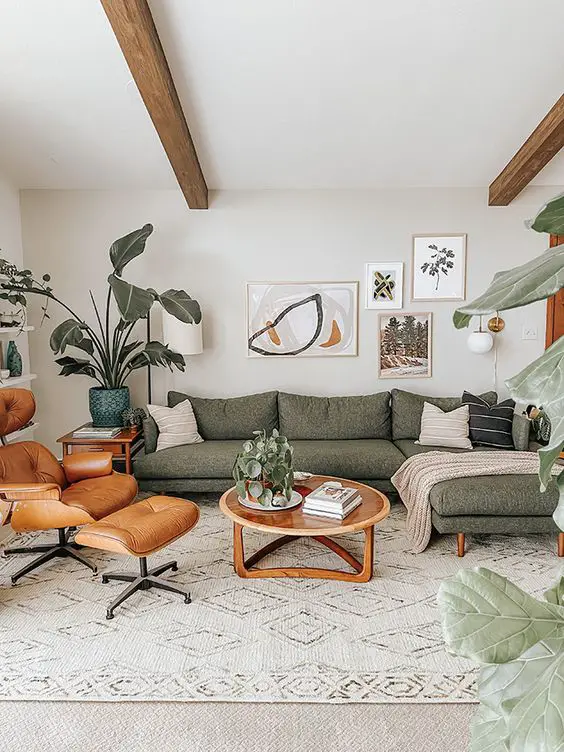
In this example, observe how a rug, closely matching the floor in color yet adorned with a pattern, does not introduce stark divisions, yet strategically defines the space.
Striking the right balance between definition and division is key.
Remember, the goal is for the rug to unify the furniture within the space.
Ensure all pieces of furniture are either entirely on the rug or, at the very least, the front legs are on the rug if it is too small.
Conversely, using a too-small rug could result in the opposite effect, making the area appear smaller than it actually is.
Small living room ideas Curtains
Think about curtains as another visual trick.
Opting for a color that closely matches both the curtains and the walls can create a sense of openness and unity.
Even darker shades can make a room feel smaller due to the stark contrast they introduce.
Instead, choose lightweight curtains that float above the floor or, better still, are mounted as high as possible.
This approach emphasizes the vertical axis, enhancing the sensation of both height and spaciousness in the room.
If traditional curtain panels don’t suit your style or you’re aiming for a cleaner, more minimalist, or contemporary look, consider roller blinds.
The clear space on either side of the window can create the illusion of a much more airy space.
Flexibility
In the context of maximizing small living spaces, the selection and arrangement of furniture plays a pivotal role in creating an adaptable and functional environment.
Rather than committing to heavy and bulky items, the clever choice involves opting for lightweight pieces that offer flexibility and can be rearranged based on current needs or activities.
For instance, consider the strategic use of a side table that can seamlessly extend your central coffee table, providing additional surface area for snacks during social gatherings.
Similarly, incorporating ottomans into your décor not only adds an extra seating option for special occasions but also serves as a comfortable footrest during moments of relaxation.
These versatile pieces can effortlessly transition to your dining area, accommodating an unexpected guest at lunch.
Glass & acrylic
In small living areas, specific materials can emerge as true saviors, blending seamlessly into your decor without adding visual weight.
When navigating through a crowded space, consider the elegance and practicality of transparent furnishings and accessories made from glass, crystal, or acrylic.
For instance, if your living room is dominated by heavy, dark furniture, you can instantly brighten and open up the space with a sleek glass coffee table.
Should you find a sideboard or buffet appearing too bulky or cluttered, elegant crystal vases can introduce a sense of lightness.
In situations where ottomans seem overly imposing, incorporating an acrylic bench can significantly alleviate the heaviness of a specific area.
Through these strategic additions, our brains intuitively overlook these pieces, effectively manipulating how we perceive the space around us.
Opting for these particular materials in certain scenarios can cleverly mitigate the feeling of a cramped living room, providing relief in areas that feel overly congested.
Employ these elements thoughtfully and sparingly to maintain the balance in your decor.
Avoid overusing it, as it might lead to an uncomfortable appearance, detracting from the beauty and sophistication of your living space.
Mirrors
It’s a well-acknowledged fact among interior design enthusiasts and professionals alike that mirrors are an unbeatable element when it comes to enhancing small spaces.
Besides creating an illusion of expansiveness by reflecting light throughout the room, mirrors play a pivotal role in elevating the aesthetic appeal of interiors and creating focal points that catch the eye.
Particularly, round mirrors adorned with exquisite frames, those featuring organic shapes, or ones that boast substantial dimensions, stand out as perfect allies for small living rooms.
The optimal strategy for utilizing mirrors in compact areas involves selecting pieces of considerable size.
It’s even feasible to employ them in a wall-to-wall fashion or extending up to the ceiling, thereby generating a profound sense of spaciousness.
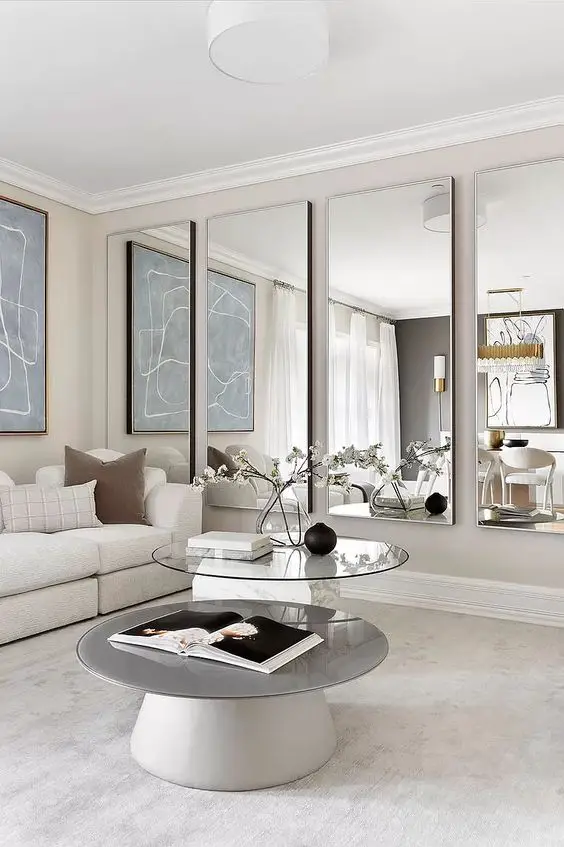
Consider this small living room example where the decision was made to outfit the back wall with a comprehensive composition with large mirrors.
This technique instantly augments the spatial perception, rendering the area significantly more radiant and appearing larger.
Small living room ideas Nature
Nature possesses an unmatched beauty, offering a dynamic way to breathe life into smaller living areas.
It introduces color, texture, and vitality, enhancing the ambiance of any room.
The key lies in leveraging creativity to seamlessly blend these natural elements within your home’s decor.
The strategic placement of a few tropical leaves or a singular branch in a minimalist glass vase can transform a humble dresser or coffee table into a captivating focal point.
However, for those facing the challenge of limited floor space or crowded surfaces, the solution doesn’t need to be confined to traditional setups.
Homeowners who cherish nature but contend with compact living quarters have the option to elevate their greenery—quite literally.
By utilizing wall space or suspending plants from the ceiling near a window, you can introduce a refreshing vibrancy without compromising on space.
Prints & patterns
In the context of small living rooms, it’s essential to balance creativity and restraint when introducing patterns and prints into the mix.
While it’s true that excessive use of intricate designs can overwhelm a petite space, completely shying away from them is not advisable either.
Patterns and prints lend character and style, transforming a plain room into a reflection of your unique aesthetic.
For those contemplating integrating patterns into their decor, the strategy lies in selecting small to medium-sized accent pieces such as throw pillows or blankets.
It is wise to limit your palette to two or three patterns, designating one as the primary, another as secondary, and optionally, a third for accents.
These should then be artfully combined with solid tones.
When it comes to larger items, like area rugs or an upholstered armchair, choose designs with soft colors that blend seamlessly with the room’s overall palette, ensuring they complement rather than dominate the space.
Take, for instance, a diminutive living area—introducing a rug with an engaging pattern can significantly enhance the room’s vitality and dynamism.
However, selecting a hue similar to the flooring can create an illusion of continuity, making the pattern appear as an integral part of the space rather than an addition.
This approach confirms that even small spaces can exude fun and flair, provided each element is thoughtfully curated.
Our living spaces, regardless of size, offer vast potential for personal expression and creativity.
By cleverly incorporating patterns and prints, homeowners can craft vibrant, stylish interiors that stand out.
Remember, the key to unlocking the charm of small spaces lies in the judicious use of decorative elements, ensuring each addition contributes to a harmonious and inviting atmosphere.
Unifiy spaces
When your living room shares space with other areas like the dining room or kitchen island, try to blend both spaces.
It’s better to define each area with textures or finishes rather than blocking the visual connection with full-height bookshelves or cabinets.
It’s more visually appealing to have the spaces complement each other, creating a unified feel.
You can use furniture to divide the space, but ensure they are low enough not to obstruct the view from one area to another.
Make sure the furniture, colors, and details in both areas are consistent and harmonious to enhance the cohesion and unity of the spaces.
Lamps
When it comes to interior lighting, unforgettable illumination is key.
In small spaces, avoid overcrowding with various eye-catching ceiling, floor, or table lamps.
Opt for architectural lighting like recessed fixtures or LED strips that seamlessly blend into your space, maintaining a sleek aesthetic while providing focused and efficient lighting.
A clever small living room ideas is to consider adding accent lights where needed and if the space allows, a central pendant light or wall sconce can elevate the room’s ambiance.
By utilizing ceilings and walls for lighting solutions, you free up surfaces for other purposes in a smart and stylish manner.
Small living room ideas Custom furniture
Make the most of your small living room by opting for bespoke furniture.
Utilize a corner or wall to fit a custom bookshelf that complements your home’s architecture.
Take advantage of a window by creating extra seating below it.
These solutions seamlessly blend with your space, adding elegance and functionality without looking like add-ons.
Your room will appear more organized, stylish, and incredibly functional.
Exterior transition
Another small living room ideas for areas adjacent to outdoor spaces, no matter how big or small, is to make the most of that additional sense of space.
Choose coordinating furniture to decorate both areas, creating a unified feel when transitioning between spaces.
This can help any small room feel much larger by incorporating the outdoors as part of it.
An illuminating tip is to light up your exteriors – brighten your balcony with plant lights or create a vertical garden on a wall.
By illuminating these areas at night, you can enhance visual permeability and bring life and movement indoors, making the space more captivating and dynamic.
Incorporating lighting in this way can transform even modest garden spaces like mine did for my dining area.
The plants appeared larger and added style and dynamism to the setting.
Utilize your small garden, terrace, or balcony adjacent to the living room at night to elevate your décor and breathe new life into it.
Draw eyes upward
In a cozy room with limited floor space, striking the perfect balance of decor is key.
If your living area feels cramped due to furniture crowding, fear not.
By shifting attention to the walls and ceiling, you can create harmony even in a snug setting.
When every inch of the floor is spoken for but the walls remain bare, the room may feel off-kilter.
Combat this imbalance by hanging a couple of artworks – they work wonders in adding equilibrium.
Floor-to-ceiling curtains also play a vital role in expanding visual space; their verticality draws the eye upward, amplifying the room’s height and creating an illusion of spaciousness through clever visual tricks.
Funcionality
It’s no secret that sometimes we end up with pieces at home that we don’t really use.
If you have items in your living room that lack function or are simply not used anymore, consider moving them out to make space for more practical and purposeful pieces.
Ensure each piece in your living room serves a purpose and adds functionality without cluttering high-traffic social areas like the living room.
Are you already using many of these ideas in your living room?
I would love to know if you’ve come across a new small living room ideas today that you’d like to try out.
Feel free to share in the comments below!
This article is part of the small spaces series.
If you’re interested in exploring more about other small areas in your home, such as bedrooms, bathrooms, and additional general tips, I’ll include links below.
Don’t forget to Pin!


If you love having an elegant and beautiful home and want to keep learning about design, I recommend checking out these articles.
- 7 common bathroom mistakes
- 7 tips for a minimalist bathroom
- Luxurious living room best transformation tips
- Hanging Wall Art – A Comprehensive Guide
Sending you a big hug with much love. Don’t forget to share your tips for achieving a fancy bedroom!
This post might contain affiliate link(s). As an affiliate, I may earn a small advertising /referral fee if you purchase through my link, without any extra cost to you, and it helps keep this little blog afloat. Thanks so much for your support!


